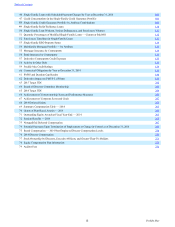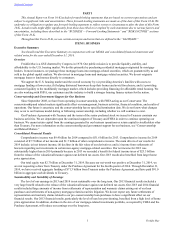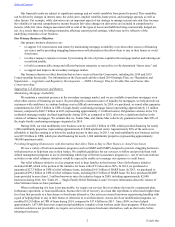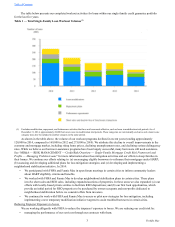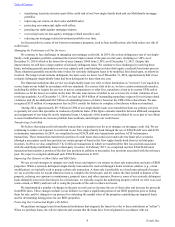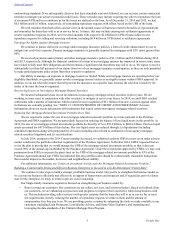Freddie Mac 2014 Annual Report Download - page 9
Download and view the complete annual report
Please find page 9 of the 2014 Freddie Mac annual report below. You can navigate through the pages in the report by either clicking on the pages listed below, or by using the keyword search tool below to find specific information within the annual report.
4Freddie Mac
• transferring to private investors part of the credit risk of our New single-family book and our Multifamily mortgage
portfolio;
• improving our returns on short sales and REO sales;
• protecting our contractual rights with sellers;
• pursuing our rights against mortgage insurers;
• recovering losses on non-agency mortgage-related securities; and
• reducing our mortgage-related investments portfolio over time.
As discussed above, many of our borrower-assistance programs, such as loan modifications, also help reduce our risk of
credit losses.
Managing the Performance of Our Servicers
We continue to face challenges in managing our mortgage credit risk. In 2014, the serious delinquency rate of our single-
family credit guarantee portfolio continued the trend of improvement of the past several years, declining to 1.88% as of
December 31, 2014 (which is the lowest level since January 2009) from 2.39% as of December 31, 2013. Despite this
improvement, we still have a large number of seriously delinquent loans. We continue to face challenges in resolving these
loans, including general constraints on servicer capacity and court backlogs in states that require a judicial foreclosure process.
These situations generally extend the time it takes for seriously delinquent loans to be modified, foreclosed upon, or otherwise
resolved. The longer a loan remains delinquent, the more costs we incur. As of December 31, 2014, approximately half of our
seriously delinquent single-family loans had been delinquent for more than one year.
The financial institutions that service our single-family loans (we refer to these institutions as "servicers") are required to
service loans on our behalf in accordance with our standards. If a servicer fails to do so, we have certain contractual remedies,
including the ability to require the servicer to pay us compensatory or other fees, repurchase a loan at its current UPB, and/or
reimburse us for the losses we realize on the loan. We also issue notices of defect to our servicers for certain violations of our
servicing standards. As of December 31, 2014, we had: (a) $0.4 billion of outstanding repurchase requests for servicing related
violations; and (b) an additional $0.2 billion of outstanding notices of defect, based on the UPB of the related loans. We also
recognized $335 million of compensatory fees in 2014, mostly for failures to complete a foreclosure within our timelines.
During 2014, approximately $9.7 billion in UPB of our single-family loans were transferred from our primary servicers
to specialty servicers that specialize in workouts of problem loans. (This figure excludes transfers between affiliated companies
and assignments of servicing for newly originated loans.) A majority of the transfers were facilitated by us as part of our efforts
to assist troubled borrowers, increase problem loan workouts, and mitigate our credit losses.
Transferring Credit Risk
We believe that using credit risk transfer transactions is a prudent way for us to manage our mortgage credit risk. We are
continuing to reduce our exposure to credit risk in our New single-family book through the use of STACR debt note and ACIS
(re)insurance transactions. In 2014, we completed seven STACR debt note transactions and three ACIS (re)insurance
transactions. These transactions transferred a portion of credit losses that could occur under adverse home price scenarios
(through a mezzanine credit loss position) on certain groups of loans in the New single-family book from us to third-party
investors. In 2014, we also completed 17 K Certificate transactions in which we transferred the first loss position associated
with the underlying multifamily loans to third-party investors. In February 2015, we completed our first STACR debt note
transaction that transfers a portion of the first loss position in addition to mezzanine loss positions associated with the reference
pool. We expect to complete additional such STACR transactions in 2015.
Improving Our Returns on Short Sales and REO Sales
We use several strategies to mitigate our credit losses and improve our returns on short sale transactions and sales of REO
properties. When a seriously delinquent single-family loan cannot be resolved through a home retention solution (e.g., a loan
modification), we typically seek to pursue a short sale transaction. A short sale is preferable to a foreclosure primarily because
we: (a) avoid the costs we would otherwise incur to complete the foreclosure; and (b) reduce the time needed to dispose of the
property, reducing our exposure to maintenance, property taxes, and other expenses. However, some of our seriously delinquent
loans ultimately proceed to foreclosure. In a foreclosure, we typically acquire the underlying property (which we refer to as real
estate owned, or REO), and later sell it, using the proceeds of the sale to reduce our losses.
We implemented a number of changes in the past several years to increase the use of short sales and increase the proceeds
from REO sales. These changes include: (a) an initiative to repair a significant portion of our REO properties prior to listing
them for sale; and (b) changes to our process for evaluating the market value of the properties underlying our impaired loans
and for determining listing prices for our REO properties.
Protecting Our Contractual Rights with Sellers
We purchase mortgage loans from financial institutions that originate the loans (we refer to these institutions as "sellers").
When we purchase loans, the sellers represent and warrant that the loans have been originated in accordance with our
Table of Contents




